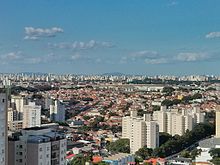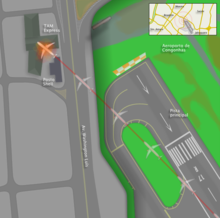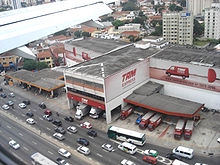LATAM Airlines Brasil, formerly TAM Linhas Aéreas, is the Brazilian brand of LATAM Airlines Group operating international and domestic flights from hubs in Brasília, Fortaleza, and São Paulo. According to the National Civil Aviation Agency of Brazil (ANAC), between January and December 2023, LATAM had 37.8% of the domestic, and 18.2% of the international market share in terms of passenger-kilometers flown, making it the largest domestic and largest international airline in Brazil.
Viação Aérea São Paulo S/A, better known as VASP, was an airline with its head office in the VASP Building on the grounds of São Paulo–Congonhas Airport in São Paulo, Brazil. It had main bases at São Paulo's two major airports, São Paulo–Congonhas Airport (CGH) and São Paulo/Guarulhos International Airport (GRU).

In aeronautics, a spoiler is a device which intentionally reduces the lift component of an airfoil in a controlled way. Most often, spoilers are plates on the top surface of a wing that can be extended upward into the airflow to spoil the streamline flow. By so doing, the spoiler creates a controlled stall over the portion of the wing behind it, greatly reducing the lift of that wing section. Spoilers differ from airbrakes in that airbrakes are designed to increase drag without disrupting the lift distribution across the wing span, while spoilers disrupt the lift distribution as well as increasing drag.

Porto Alegre–Salgado Filho International Airport is the airport serving Porto Alegre and the region of Greater Porto Alegre, Brazil. Since October 12, 1951, it is named after the Senator and first Minister of the Brazilian Air Force Joaquim Pedro Salgado Filho (1888–1950).
TransBrasil was a Brazilian airline which ceased operations on 3 December 2001. During most of its history, Transbrasil was owned by local entrepreneur Omar Fontana. Its aircraft usually featured a colorful livery, remarkably with a rainbow on the tail fin. Transbrasil base was President Juscelino Kubitschek International Airport in Brasília. From the 1970s and until its demise in 2002, Transbrasil was usually the third largest Brazilian airline after Varig and VASP, serving both domestic and international routes.

São Paulo/Congonhas–Deputado Freitas Nobre AirportPortuguese pronunciation:[kõˈɡõɲɐs] is one of the four commercial airports serving São Paulo, Brazil. The airport is named after the neighborhood where it is located, called Vila Congonhas, property of the descendants of Lucas Antônio Monteiro de Barros (1767–1851), Viscount of Congonhas do Campo, first president of the province of São Paulo after the independence of Brazil in 1822, during the Empire. In turn, the Viscount's domain was named after the plural of a shrub known in Brazil as congonha-do-campo. Since June 19, 2017, it is officially named after Deputy José Freitas Nobre. The name Congonhas, however, remains mostly used. It is owned by the City of São Paulo.

Santos Dumont Airport is the second major airport serving Rio de Janeiro, Brazil. It is named after the Brazilian aviation pioneer Alberto Santos Dumont (1873–1932).

The Embraer EMB 110 Bandeirante is a Brazilian twin-turboprop light transport aircraft designed by Embraer for military and civil use.
Avianca Brasil S.A., officially Oceanair Linhas Aéreas S/A, was a Brazilian airline based in Congonhas Airport in São Paulo, Brazil. According to the National Civil Aviation Agency of Brazil (ANAC), which cancelled its operation, prior to cessation of operations, from January to December 2018 Avianca Brasil had 13.4% of the domestic and 7.3% of the international market share in terms of passengers per kilometer flown, making it the fourth-largest airline both in domestic and international traffic in Brazil. The company slots were redistributed by Anac. An auction on 10 July 2019 raised R$555.3 million, not enough to pay a debt of R$2.7 billion, although Avianca's bankruptcy was not officially decreed.

Philippine Airlines Flight 137 was a scheduled passenger flight from Ninoy Aquino International Airport in Manila to Bacolod City Domestic Airport in Bacolod.

TAM Transportes Aéreos Regionais Flight 402 was a scheduled domestic flight from Caxias do Sul, Brazil, to Recife International Airport in Recife, via São Paulo–Congonhas International Airport and Santos Dumont Airport in Rio de Janeiro. On 31 October 1996, at 8:27 (UTC-2), the starboard engine of the Fokker 100 operating the route reversed thrust while the aircraft was climbing away from the runway at Congonhas. The aircraft stalled and rolled beyond control to the right, then struck two buildings and crashed into several houses in a heavily populated area only 25 seconds after takeoff. All 95 people on board were killed, as well as another 4 on the ground. It is the fourth deadliest accident in Brazilian aviation history, the second at the time. It is also the deadliest aviation accident involving a Fokker 100.

Lufthansa Flight 2904 was an Airbus A320-200 flying from Frankfurt, Germany to Warsaw, Poland that overran the runway at Okęcie International Airport on 14 September 1993.

Voepass Linhas Aéreas, stylized as VOEPASS Linhas Aéreas and previously known as Passaredo Linhas Aéreas, is an airline based in Ribeirão Preto, São Paulo, Brazil. It operates regional services in Brazil. Its main base is Leite Lopes Airport, Ribeirão Preto.

Between 2006 and 2007, Brazil's civil aviation sector suffered a crisis characterized by significant flight delays and cancellations, air traffic controller strikes and safety concerns about the country's airport and air traffic infrastructure. It ostensibly started after the crash of Gol Flight 1907 in September 2006, and extended to January 2008. While the government has announced a series of measures aimed at mitigating its effects, no clear solution has been found. In Brazil the crisis has been dubbed "Apagão Aéreo", an allusion to an energy crisis which Brazil experienced between 2001 and 2002.

TACA Flight 390 was a scheduled flight on May 30, 2008, by TACA International from San Salvador, El Salvador, to Miami, Florida, United States, with intermediate stops at Tegucigalpa and San Pedro Sula in Honduras. The aircraft, an Airbus A320-233, overran the runway after landing at Tegucigalpa's Toncontín International Airport and rolled out into a street, crashing into an embankment and smashing several cars in the process.

ExcelAire, LLC is a United States air charter company based at Long Island MacArthur Airport in Ronkonkoma, New York. ExcelAire LLC specializes in worldwide jet and helicopter charters, aircraft management, maintenance and aircraft sales.
VARIG was the first airline founded in Brazil, in 1927. From 1965 until 1990, it was Brazil's leading airline and virtually its only international one. In 2005, Varig went into judicial restructuring, and in 2006 it was split into two companies – Flex Linhas Aéreas, informally known as "old" Varig, heir to the original airline – now defunct, and "new" Varig, a new company, fully integrated into Gol Airlines.

Comandante João Ribeiro de Barros Airport is an airport serving Bauru, Brazil.
Márcio Rogério de Andrade was a Brazilian football player and a FIFA accredited football agent. Márcio and his family died on July 17, 2007, during an air disaster involving an Airbus A320 where they are all onboard TAM Airlines Flight 3054.

The Cruzeiro do Sul Flight 144 was a domestic commercial route operated by Serviços Aéreos Cruzeiro do Sul, departing from Belo Horizonte to Rio de Janeiro, with stops in Florianópolis, Curitiba, Porto Alegre, and São Paulo. On the night of May 3, 1963, the aircraft operating this route, a Convair 340 registration PP-CDW, took off from Congonhas Airport in São Paulo at 19:30, bound for Santos Dumont Airport, Rio de Janeiro. Shortly after takeoff, the crew received an audible warning of an engine fire and attempted to return to the airport. During the maneuver, the aircraft lost altitude and crashed, resulting in the deaths of 37 occupants and injuries to another thirteen.




























